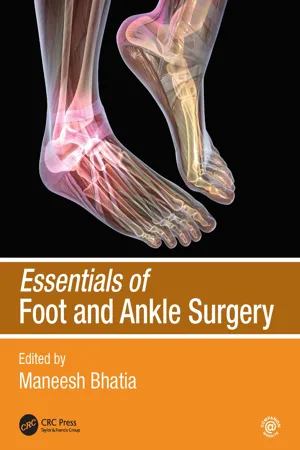
- 294 pages
- English
- ePUB (mobile friendly)
- Available on iOS & Android
Essentials of Foot and Ankle Surgery
About this book
This book is a 'go-to' guide for postgraduate Orthopaedic examinations as well as for Orthopaedic surgeons for trauma and elective foot and ankle surgery.
A streamlined approach ensures that the 22 core topics are covered in a succinct and practical way. Foot and ankle surgery is a vast topic that can be daunting to revise due to the complex and diverse nature of associated pathologies. This highly illustrated succinct text, together with key learning points ensures a rapid understanding of all the essential elements of foot and ankle surgery.
* Provides 'need -to-know' information for Orthopaedic surgeons
* Assists with exam preparation for postgraduate exit exams such as the FRCS (Trauma & Orth)
* Simple, succinct and concise
* Over 500 illustrations to aid learning
* Accompanying website with MCQs and videos of clinical examination and surgical techniques
Orthopaedic surgeons, registrars and trainees, other specialty doctors, general practioners and physiotherapists with musculoskeletal interest and podiatrists will all find here 'gold standard' answers to foot and ankle conditions.
Frequently asked questions
- Essential is ideal for learners and professionals who enjoy exploring a wide range of subjects. Access the Essential Library with 800,000+ trusted titles and best-sellers across business, personal growth, and the humanities. Includes unlimited reading time and Standard Read Aloud voice.
- Complete: Perfect for advanced learners and researchers needing full, unrestricted access. Unlock 1.4M+ books across hundreds of subjects, including academic and specialized titles. The Complete Plan also includes advanced features like Premium Read Aloud and Research Assistant.
Please note we cannot support devices running on iOS 13 and Android 7 or earlier. Learn more about using the app.
Information
1 Foot and ankle examination
Introduction
History
General inspection


Gait
- First Rocker: Period between heel strike and foot flat. Eccentric tibialis anterior contraction controls foot drop and the plantarflexion moment occurring about the ankle. The heel ground reaction force (GRF) occurs behind the ankle joint, resulting in ankle movement from neutral to 10° plantarflexion.
- Second Rocker: Period between foot-flat and heel-off. The ankle...
Table of contents
- Cover
- Half Title
- Title Page
- Copyright Page
- Dedication
- Contents
- Foreword
- Preface
- Contributors
- Companion Website
- 1 Foot and ankle examination
- 2 Applied anatomy and surgical approaches
- 3 Biomechanics of the foot and ankle
- 4 Principles of foot and ankle orthoses
- 5 Paediatric and adolescent foot disorders
- 6 Forefoot disorders
- 7 The rheumatoid foot
- 8 Pes plano valgus
- 9 The cavovarus foot
- 10 Inferior heel pain
- 11 Ankle arthritis
- 12 Ankle instability
- 13 Achilles disorders
- 14 Achilles tendon rupture
- 15 Ankle fractures
- 16 Lisfranc injuries
- 17 Fractures of the talus
- 18 Calcaneal fractures
- 19 Management of diabetic foot
- 20 Surgical principles of amputations
- 21 Principles of lower limb prosthetics and rehabilitation
- 22 Foot and ankle radiology
- Index